Reichsbahn 1941 Pattern Pay Group 7a-11 Visor Cap
CATEGORY: Version
SKU: 72.GOR.01.01.03.003.000
Estimated market value:
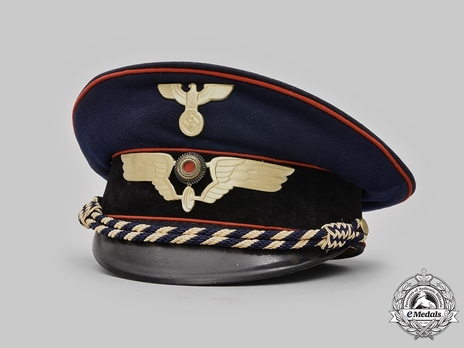
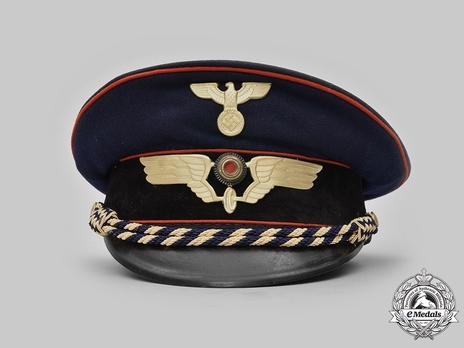
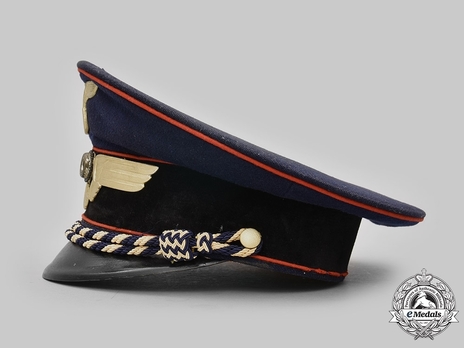
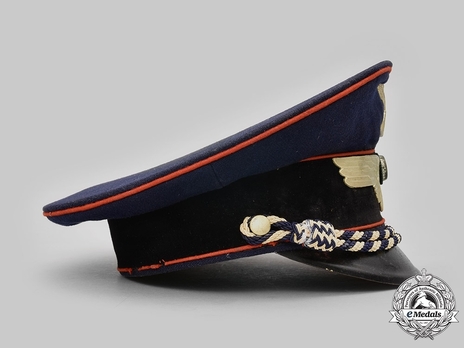
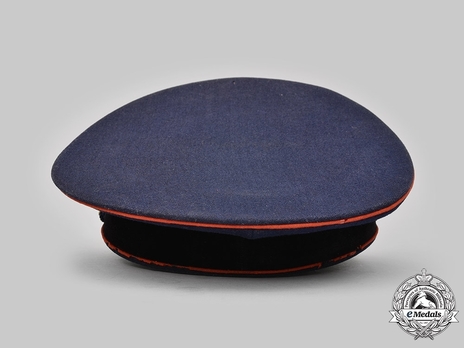
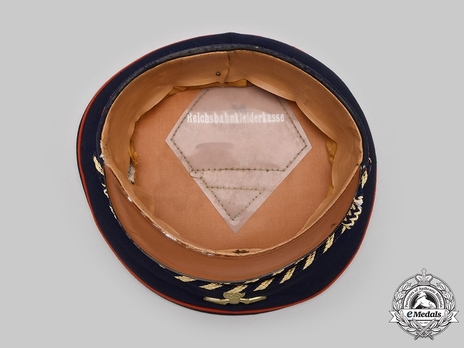
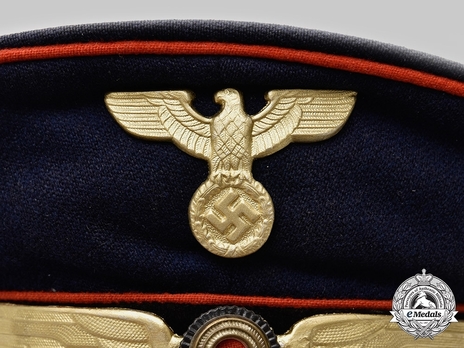
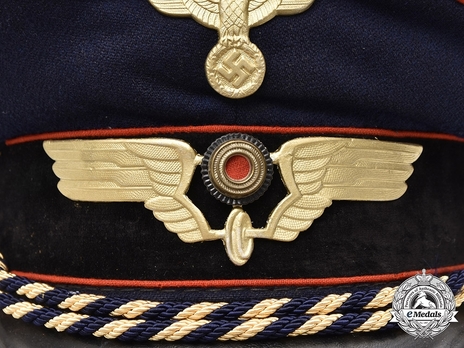
Estimated market value:
Constructed of dark blue wool twill. It features reinforced side walls, fully lined on the exterior with a smooth black doeskin wool cap band. Both the top and bottom edges of the cap band are trimmed with red wool piping, while an additional band of identical piping trims the outer edge of the crown. Pinned onto the peak is a gilded aluminum insignia consisting of a government-style German national eagle clutching a wreathed mobile swastika. Measuring 55 mm (w) x 36 mm (h), the eagle retains both of its reverse attachment prongs and is maker marked with the logo of F.W. Assmann & Söhne, Lüdenscheid. Pinned onto the centre of the cap band directly underneath the eagle is a second insignia consisting of a non-magnetic metal and wool tri-colour cockade, set within gilded aluminum wings and a Reichsbahn insignia. The cap band insignia measures 135 mm (w) x 40 mm (h). The cap band is also flanked by pebbled and gilded magnetic metal buttons securing in place a decorative chinstrap constructed of multiple rows of twisted and rolled gold bullion wire and dark blue threaded piping. The chinstrap features dual sliding knots and rests upon a protruding vulcanfibre visor, finished in a matte black on the obverse and in a matte brown on the reverse. The interior of the side walls is fully lined with a light brown leatherette sweatband measuring 45 mm in width. The interior is also encompassed by a brown oilcloth liner, with the crown retaining a transparent plastic moisture guard. A silvered mark of “REICHSBAHNKLEIDERKASSE” is visible underneath the guard, indicating that the cap was purchased from the Reichsbahn clothing office. It is also marked in black ink with a size mark of “56”. The cap measures approximately 255 mm (w) x 240 mm (l) x 150 mm (h). Issues consistent with age and use are evident, and includes material fatigue and mothing to the outer wool and piping, with distortion of the cap band and structure, and deterioration of the sweatband and interior liner. The cap is in an overall very fine condition.
The Deutsche Reichsbahn (German National Railway) was created after the First World War in 1920 by combining the formerly independent state railways of the abolished German Empire into a national organisation. Under NSDAP rule, the German state railway system was reorganised in the 1930s to better meet the needs of the economy and to prepare for war, eventually supplying the front lines with soldiers and supplies. The Reichsbahn also had an infamous role to play in the Holocaust, transporting Jews and other “undesirables” to concentration and extermination camps.
The Bahnschutzpolizei (railway protection police) was founded in 1939 as a merger of the Bahnpolizei (railway police) and the Reichsbahnschutz (railway protection force), the latter being regular railway employees that, beyond their normal functions, additionally served as railway security personnel.
The Bahnschutzpolizei as a railway sub-organisation was made up of policemen that were employed by the Reichsbahn rather than the German police force. Their task was to ensure railway safety as well as preventing railway-related espionage and sabotage. During the war, most members of the Bahnschutzpolizei served in the occupied Eastern European territories.
The visor cap worn by Reichsbahn personnel prior to 1930 was either blue or red with a black cap band and red piping above and below it. It featured a black visor and no chin straps or cords. A national cockade was attached to the cap band and a state cockade at the top of the cap with a gilt metal insignia above it in the form of a wheel viewed from the front with a wing attached to each side.
This cap was worn until new regulations in June of 1934 dictated that the state cockade and winged wheel insignia were to be discontinued and replaced with a silver-coloured Third Reich “political” style national eagle emblem with swastika.
New regulations from July 1935 introduced chin straps and chin cords, depending on rank.
The highest ranks down to and including pay group 7 personnel wore gold-coloured chin cords interwoven with dark blue.
Pay group 7a to 11 personnel wore alternating gold-coloured and dark blue chin cords.
Pay group 12 to 17 personnel wore dark blue chin cords with interwoven gold.
Members of the lowest ranks wore black leather chin straps.
Bahnpolizei visor caps were introduced in 1936/37. They are very similar to regular Reichsbahn visor caps, with a few key differences.
The caps are dark blue and feature aluminum cord piping for higher ranks (Streifdienstleiter to Streifabteilungsführer). Lower ranks (Oberstreifenführer to Streifer) wore red piping instead. Initially, the piping was only found above and below the black cap band, but eventually the crown of the cap was also piped.
The higher ranks wore chin cords made of aluminum cord with interwoven black cord, while the lower ranks wore black leather chin straps.
Higher ranked Bahnpolizei members wore a hand-embroidered winged wheel and oak leaf wreath insignia complete with a cockade on the cap band. Lower ranked members wore the same insignia, but made of silver-coloured metal. At the top of the cap, all ranks wore a metal eagle emblem.
Bahnpolizei visor caps were also produced in a field-grey version with a dark green or black cap band. Piping was silver-coloured for higher ranks and black for lower ranks.
Bahnschutz members wore the same cap as Bahnpolizei members. The winged wheel insignia was made of silver-coloured metal for Enlisted Ranks, hand-embroidered from silver-coloured aluminum cord for Officer ranks beginning with Oberzugführer/Abteilungsführer, and gold-coloured hand-embroidered for higher leader ranks beginning with Gruppenleiter.
Enlisted Ranks wore a black leather chin strap, while Oberzugführer, the highest enlisted rank, wore an aluminum chin cord interwoven with blue or black. Officers beginning with Abteilungsführer wore an aluminum chin cord.
With the amalgamation of Bahnpolizei and Bahnschutz to Bahnschutzpolizei in 1939, a cap in the Bahnschutz design with slight differences was elected as headgear.
Piping was grey for Enlisted Ranks, silver-coloured for Officers, and gold-coloured for higher leaders.
The insignia remained the same, except that a gold-coloured eagle emblem was introduced for higher leader ranks. They were also granted permission to wear a gold-coloured chin cord.
New regulations for Reichsbahn visor caps were introduced in February of 1941. Red piping was added to the cap crown. A new insignia was introduced as well, made up of a large winged wheel, a wheel viewed from the front with a wing attached on each side, with the cockade placed above the wheel and in between the wings.
Gold-coloured piping was introduced in July of 1941 for members of pay groups 5 and above.

Comments
Sign in to comment and reply.


Scroll Top